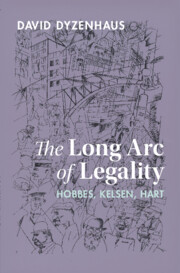Book contents
- The Long Arc of Legality
- The Long Arc of Legality
- Copyright page
- Dedication
- Contents
- Preface
- Introduction
- 1 The Puzzle of Very Unjust Law I
- 2 The Puzzle of Very Unjust Law II
- 3 The Constitution of Legal Authority / The Authority of Legal Constitutions
- 4 The Janus-Faced Constitution
- 5 The Politics of Legal Space
- 6 Legality’s Promise
- Book part
- Bibliography
- Index
5 - The Politics of Legal Space
Published online by Cambridge University Press: 13 January 2022
- The Long Arc of Legality
- The Long Arc of Legality
- Copyright page
- Dedication
- Contents
- Preface
- Introduction
- 1 The Puzzle of Very Unjust Law I
- 2 The Puzzle of Very Unjust Law II
- 3 The Constitution of Legal Authority / The Authority of Legal Constitutions
- 4 The Janus-Faced Constitution
- 5 The Politics of Legal Space
- 6 Legality’s Promise
- Book part
- Bibliography
- Index
Summary
Central to philosophy of law, I have argued, is the legal subject’s question ‘But, how can that be law for me?’ Chapter 4 explored that argument in an investigation of the interaction between the space of the modern legal state and law ‘beyond the state’. Here I investigate the difference made to the answer to the question when it is given in two different contexts: first, a context in which a legal space – one both constructed by law and ruled by law – interacts with another legal space; and, second, in a context in which a legal space interacts with a space of no-law. As we will see, the definition of a legal space as both constructed by law and ruled by law is important because law can be used to construct a space of no-law, a legal void or ‘black hole’, as Lord Steyn described the situation of detainees at the US base of Guantanamo.1 In such a space, prerogative or legally unmediated power rules.
- Type
- Chapter
- Information
- The Long Arc of LegalityHobbes, Kelsen, Hart, pp. 297 - 351Publisher: Cambridge University PressPrint publication year: 2022

